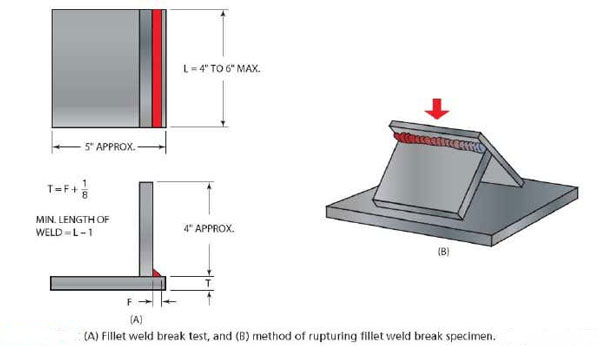Destructive testing of piping welds-Macro Etch Testing and Fillet Weld Break Test
Destructive weld testing, as the name suggests, involves the physical destruction of the completed weld in order to evaluate its characteristics. This method of testing is used frequently for a number of applications. Some of these applications include welding procedure qualification and welder performance qualification testing, sampling inspection of production welds, research inspection, and failure analysis work. A number of destructive weld testing methods are used to determine weld integrity or performance. Typically they involve sectioning and/or breaking the welded component and evaluating various mechanical and/or physical characteristics. We shall briefly examine some of the more common methods of this type of welding inspection. We shall consider the macro etch test, the fillet weld break test, the transverse tension test, and the guided bend test. We shall consider how they are used, and what types of weld characteristics they are designed to determine. We shall examine their advantages over other inspection methods and their limitations.
Macro Etch Testing – This method of testing typically involves the removal of small samples of the welded joint. These samples are polished across their cross-section and then etched using some type of mild acid mixture, dependent on the base material used. The acid etch provides a clear visual appearance of the internal structure of the weld. Particular interest is often shown at the fusion line, this being the transition between the weld and the base material. Such items as depth of penetration, lack of fusion, inadequate root penetration, internal porosity, cracking and inclusions can be detected during inspection of the etched sample. This type of inspection is obviously a snapshot of the overall weld length quality when used for sampling inspection of production welds. This type of testing is often used extremely successfully to pinpoint welding problems such as crack initiation, when used for failure analyses.

Fillet Weld Break Test
Fillet Weld Break Test – This type of testing involves breaking a sample fillet weld that is welded on one side only. The sample has load applied to its unwelded side, transverse to the weld and directed to its unwelded side (typically in a press). The load is increased until the weld has failed. The failed sample is then inspected to establish the presence and extent of any welding discontinuities. This test will provide a good indication as to the extent of discontinuities within the entire length of weld tested (normally 6 to 12 inches) rather that a cross-sectional snapspot like the macro etch test. This type of weld inspection can detect such items as lack of fusion, internal porosity and slag inclusions. This testing method is often used in conjunction with the macro etch test. These two testing methods complement each other by providing information on similar characteristics in different detail and in different ways.
For more information,please contact us: sales@haihaogroup.com
